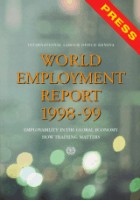
-
ILO on Training
from The Jobs Letter No.88 / 14 October 1998
 The ILO World Employment report has surveyed different approaches to training around the world with an eye to highlighting some of the strengths and shortcomings of each system.
It also sets out an agenda for improving the efficiency and governance of training systems
worldwide, to achieve the quality standards required in today's highly competitive world.
The ILO World Employment report has surveyed different approaches to training around the world with an eye to highlighting some of the strengths and shortcomings of each system.
It also sets out an agenda for improving the efficiency and governance of training systems
worldwide, to achieve the quality standards required in today's highly competitive world.
While the ILO authors insist that there is no ideal training system, they argue that any
successful system needs to take account of three factors:
-- a solid educational base
-- an appropriate incentive structure in which training priorities are fuelled by real
economic demand, and
-- institutional arrangements in which the social partners - employers, workers and government
- contribute to improving performance and efficiency.
|
|
The ILO: "Demand-led orientation of training systems has various components: Firstly, government helps private agents, both employers and individuals, to sponsor training which is in their own immediate interests. Secondly, in the training which governments sponsor in their own right, more effort is made to incorporate information about market demand for skills, and to replace government provision by private provision, using market-like mechanisms to increase efficiency..."
Public policy increasingly concentrates on encouraging enterprises and individuals to shoulder the major part of training costs by demonstrating the utility of training and encouraging greater competition in the provision of training. But, the ILO says, a number of possible models can coexist.
Training levies, which involve an annual amount being assessed by the government (usually 1 or 2% of the wage bill paid by employers) are in operation in a number of Latin American countries. Other systems, involving a levy plus grant, operate in countries as diverse as France, Singapore and Zimbabwe, wherein firms are exempted from taxes on training to the extent that they provide training themselves. In other words, firms that provide no training to their employees pay the full levy (which goes to fund national training efforts) and firms that do provide training can deduct the expenses from their levy.
The ILO also sees a need for lifelong training, in which enterprises and organizations redefine themselves as both productive entities and "learning enterprises." The practice of continuing development of skills as part of an internal career path is well entrenched in Japanese and German enterprises. However these forms of training are strongest in countries where the employer-employee relationship is based on a mutual long-term commitment or where certification is well-entrenched.
In many industries and countries, employers continue to be reluctant about paying for training since it may bid up the cost of the trained employee or generate an asset that could be easily poached by competing enterprises. Inter-firm networks are increasingly being used in order to share the cost of training among rival firms in the sector. The ILO believes the ideal result is one in which the costs of training are shared amongst all producers, who stand to profit from the enhanced pool of skilled labour.
Source "World Employment Report 1998-99 - Employability in the global economy: How training
matters," International Labour Office, Geneva, 1998. ISBN 92-2-110827-9.

Top of Page
This Letter's Main Page
Stats |
Subscribe |
Index |
The Jobs Letter Home Page |
The Website Home Page
jrt@jobsletter.org.nz
The Jobs Research Trust -- a not-for-profit Charitable Trust
constituted in 1994
We publish The Jobs Letter

Top of Page
This Letter's Main Page
Stats |
Subscribe |
Index |
The Jobs Letter Home Page |
The Website Home Page
jrt@jobsletter.org.nz
The Jobs Research Trust -- a not-for-profit Charitable Trust
constituted in 1994
We publish The Jobs Letter








